- | Regulation Regulation
- | Policy Briefs Policy Briefs
- |
A Snapshot of Regulation in Southern US States
This brief summarizes and contextualizes the volume of regulatory restrictions in select southern states using RegData, an innovative tool from the Mercatus Center at George Mason University. In 2012, the Mercatus Center launched RegData to quantify regulation at the federal level in the United States. RegData uses text analysis and machine learning algorithms to convert legal text into data. The primary unit of measurement of regulation used by RegData is regulatory restrictions, or instances of the terms shall, must, may not, prohibited, and required appearing in laws. Regulations by nature impose restrictions on regulated individuals and businesses, either by requiring or preventing some activities. These terms approximate the restrictions that regulators impose on a jurisdiction.
In 2019, the Mercatus Center launched State RegData, which extended the technology underlying RegData to state administrative codes. This allowed, for the first time, for aggregate levels of regulation across the various states to be compared to one another. This report takes a deeper dive into the data generated by the various RegData projects to better understand the regulatory landscape in the southern region of the United States. Specifically, this report summarizes data for eight states: Alabama, Florida, Georgia, Kentucky, Louisiana, Mississippi, South Carolina, and Tennessee. The report compares these states’ regulatory environments along a variety of dimensions, including overall word counts in state codes, restrictiveness of regulations in state administrative codes, restrictions across industries, federal regulation of the various states, and population-adjusted restrictions.
The analysis presented here provides new insights into the size and scope of regulation across the South, which should hopefully prove useful to academics, policymakers, and even the regulators themselves as they seek to understand the consequences of the regulatory state in America.
Word and Restriction Counts in State Regulations
Almost every state in the country has a regulatory code where its administrative laws are housed. Regulations are distinct from traditional laws written by legislators in that they are written by mostly unelected officials working at executive branch agencies who are delegated lawmaking powers from elected representatives in a legislature. Executive branch agencies are typically run by political appointees (although sometimes they are run by elected officials), and the staff who work at agencies are career civil servants. Thus, the administrative laws (i.e., regulations), written by these officials are different from statutes written by legislators in that there is generally no direct line of accountability from voters to the writers of these laws.
The simplest way to quantify how much state regulation exists is simply to count the words in states’ administrative codes (figure 1). For example, the Louisiana administrative code contained 11.2 million words as of 2019, while South Carolina’s administrative code contained just 4.7 million words.
If one instead counts the restrictive terms in administrative codes, then Florida is the most regulated state in the south, with 170,890 restrictions (figure 2). By either metric, South Carolina is the least regulated state in the South, as it has just 78,676 restrictions as of 2019.
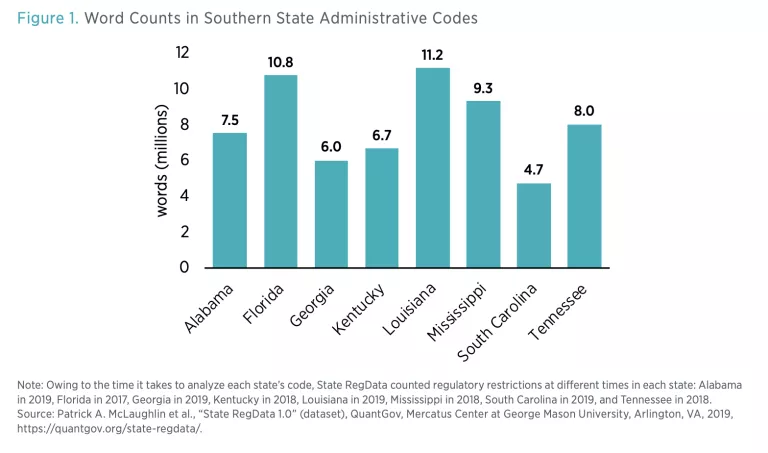
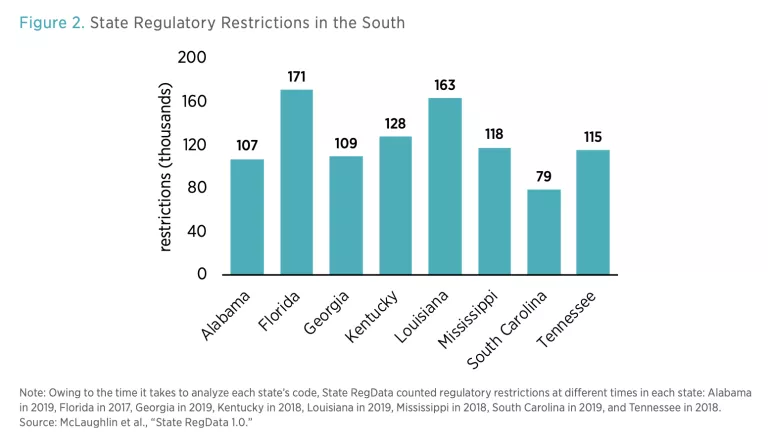
Regulation of Industry at the State and Federal Levels
A more in-depth way to analyze the regulatory systems in these states is to look at industries that are targeted by state and federal regulation. RegData utilizes machine learning algorithms that are trained to identify text relevant to particular industries. When the probability that a certain piece of legal text applies to a particular industry is combined with regulatory restriction data, one can produce an estimate of the regulatory restrictions targeting particular sectors of the economy. Figure 3a provides state regulatory restriction information for select industries. What is clear from figure 3a is that there is wide variation both within and across states. In other words, for particular industries, some states impose far more regulation than others. And within different states, some industries are far more regulated than others.
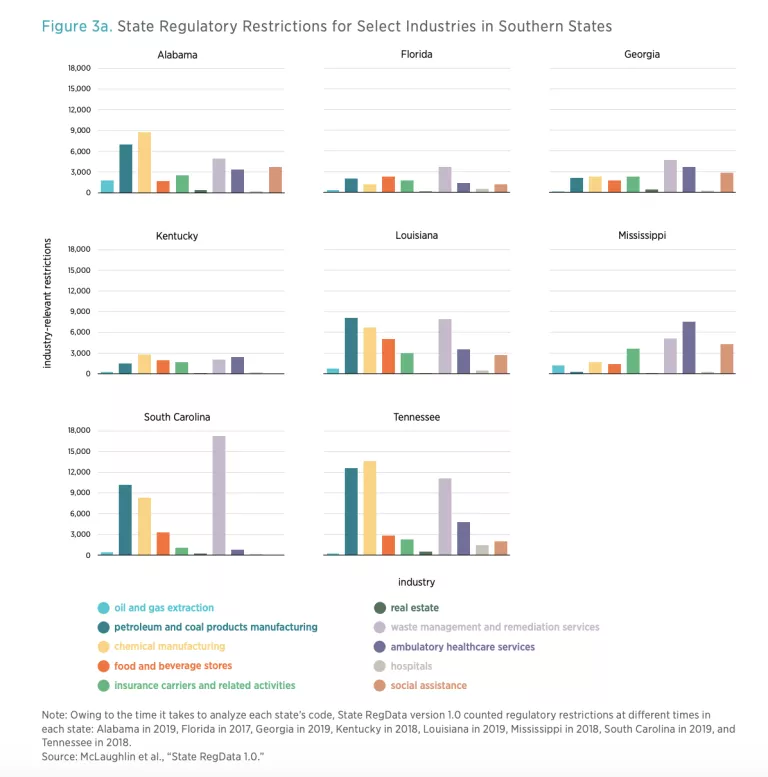
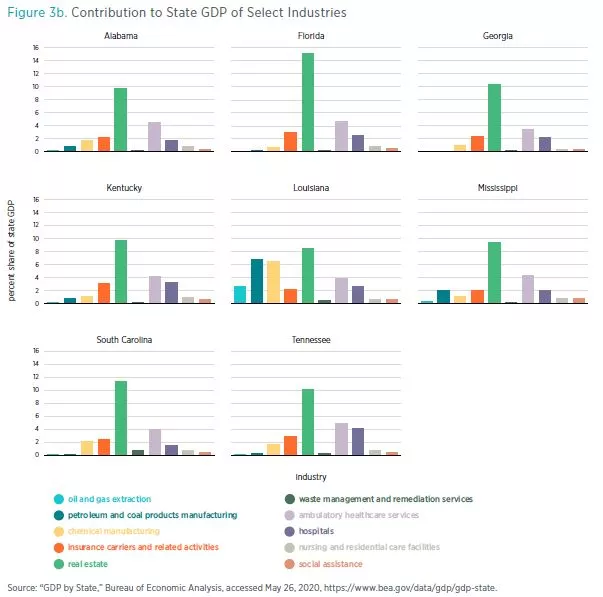
The Mercatus Center has also produced data to better understand the degree to which federal regulation targets states. By weighting estimates of industry-relevant federal restrictions according to how important various industries are to states’ gross state product, the Federal Regulation and State Enterprise index is able to rank the states in terms of how regulated they are by the federal government (figure 4). Louisiana receives a score of 2.81. This ranking is scaled relative to the nation as a whole, which receives a score of 1.00, so a score of 2.81 means that Louisiana industries are targeted by federal regulation 280 percent more than industries across the nation as a whole are. Notably, all eight states in the southern region are relatively more regulated than is the nation as a whole by this measure.
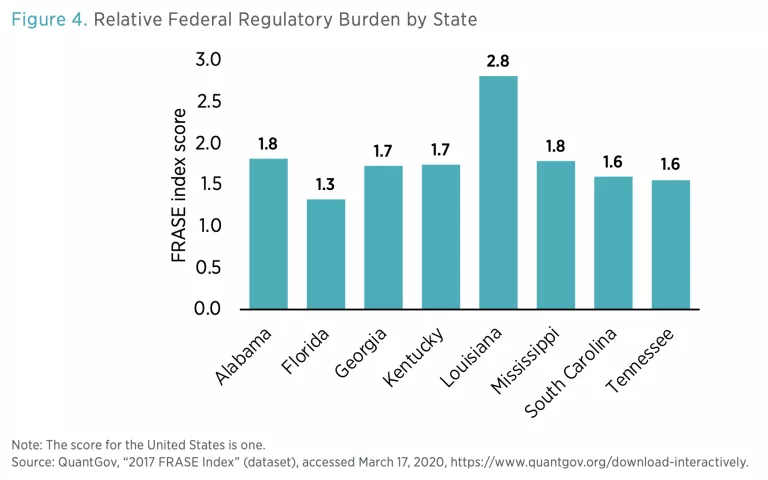
Regulation and Population
There are also reasons to believe that more populous states might tend to have more regulation than less populous states. For example, more populous states might have more industries, so some forms of regulation may not be necessary in less populous states. It is also possible that more populous states have denser population than less populated states, and when more people are congregated in smaller areas, certain externalities or other market failures could be more prevalent, thereby necessitating more regulation. Finally, some scholars have posited that there are fixed costs associated with regulating and that larger populations will be able to absorb these fixed costs more easily by spreading them across a greater number of people. Therefore, more populous states could be expected to have more regulation because it is relatively cheaper for them to impose regulation than less populous states.
For these reasons, it could make sense to adjust for population when reporting regulatory restrictions. Figure 5a shows that Mississippi is the most regulated state in the South, adjusting for population. By this measure, Florida is the least regulated state in the South.
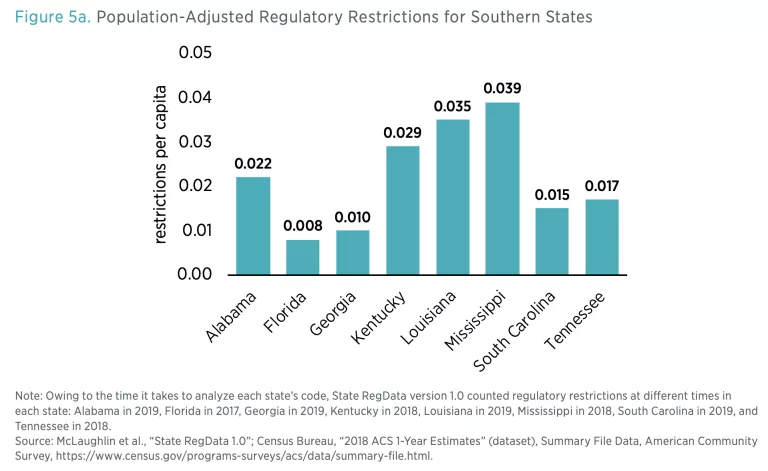
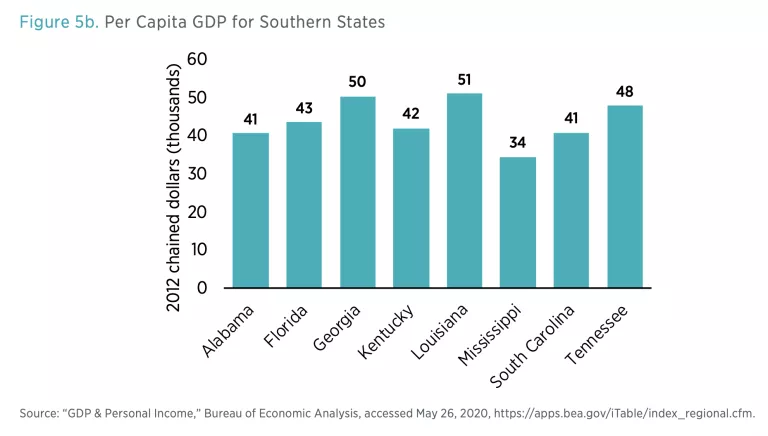
Conclusion
There are a variety of ways in which one can compare the regulatory environments across states, as this policy brief has done for states in the southern region of the United States. We have looked at word counts in state administrative codes, regulatory restriction counts, restrictions targeting industries in these states, the extent to which federal regulation targets state economies, and the population-adjusted quantity of state regulation.
Each of these metrics has its own advantages and disadvantages. All told, the amount of regulation in the states is considerable. Further research will help gauge how levels of regulation are evolving in these states over time and what implications follow from this evolution. This snapshot of state regulations, however, provides a glimpse into the reach of various kinds of regulation in the South.

